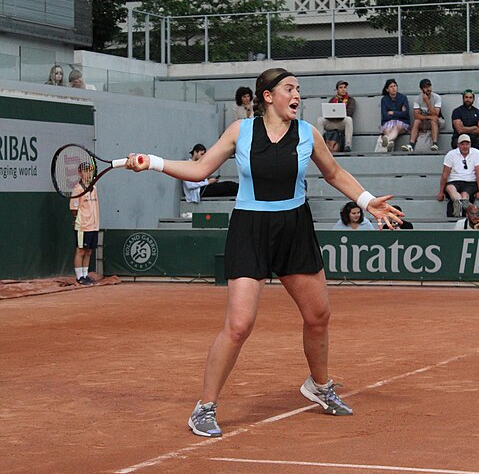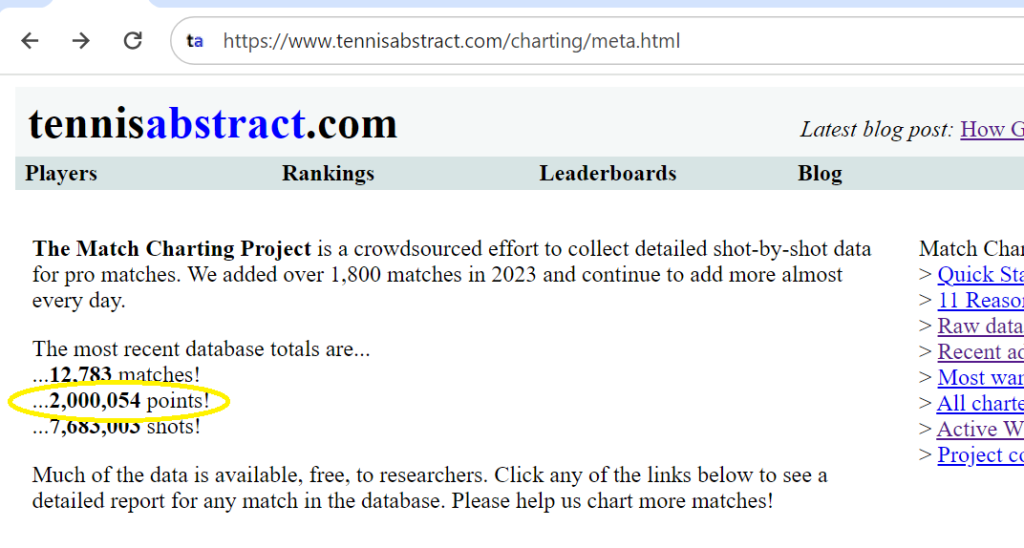Also today: Deciding tiebreaks, a MCP milestone, and assorted links.

If you’ve ever spent five minutes watching Jelena Ostapenko play tennis, you know she’s as aggressive as it gets. She swings for the fences and sometimes knocks them over. Get her on a hot streak, and opponents can only hope its ends before the handshake. When she’s off her game, spectators in the first few rows duck for cover.
What you might not realize is just how aggressive she is. A few years ago I tuned Lowell West’s Aggression Score metric so that the numbers fell in a range between 0 and 100. In theory, 0 is maximally passive; 100 is go-for-broke, all the time. Ostapenko’s career Aggression Score in rallies is 175.
This sort of extreme style lends itself to all sorts of narratives. She can beat anybody, any time, as she showed when she won the 2017 French Open as an unseeded player, and again last year when she upset Iga Swiatek at the US Open–her fourth win in as many matches against the Pole. That makes her a perennial dark horse pick at majors. Even though she hasn’t reached a semi-final since 2018, neither Iga nor Coco Gauff–who exited the Australian Open after an Ostapenko barrage last year–would like her find her in their section.
(Sorry Iga: Guess who you might face in the quarters!)
Hyper-aggressive players also appear to be works in progress. Especially early in Ostapenko’s career, commentators would talk about her stratospheric potential if she could only improve her footwork, or play a bit more “within herself.” That is, not quite so many winners, not quite so soon, more point construction, fewer unforced errors. But players rarely change much, and as they age, they are more likely to become more aggressive, not less. The Latvian is now 26 years old, beginning her ninth year on tour. What you see is what you get.
What you get, it turns out, is a lot of close matches. Ostapenko played 30 three-setters last year, including four in a row to reach the Birmingham final and another four straight to start the US Open. Alona’s apotheosis came at Indian Wells, when she faced fellow super-aggressor Petra Kvitova in the third round. Both women tallied exactly 75 points; Kvitova won, 0-6, 6-0, 6-4. Tennis ball fuzz could be seen floating over the desert for days afterward.
That particular scoreline was an oddity, but the margin of victory was not. Ostapenko’s tight matches are not a result of streakiness, flightiness, or anything of the sort. They are an unavoidable function of her game style. It’s almost impossible to hit lots of winners without also committing piles of unforced errors. (We’ll come back to that.) When you do both in such numbers, you personally account for a substantial majority of point outcomes. The winners and errors (very approximately) balance each other out, and unless your opponent does something remarkable–or remarkably bad–with the limited influence you leave her, you end up winning about half the points played.
No one takes the racket out of an opponent’s hand like Ostapenko does. Once the return is in play, the Latvian ends nearly two-thirds of points herself, with a winner or unforced error, or by forcing an error. No one else comes close. Drawing on Match Charting Project data, I’ve listed the active players who end the most rallies:
Player RallyEnd% Jelena Ostapenko 65.9% Petra Kvitova 61.6% Madison Keys 60.8% Liudmila Samsonova 60.0% Camila Giorgi 59.7% Aryna Sabalenka 59.7% Veronika Kudermetova 57.5% Danielle Collins 57.5% Ekaterina Alexandrova 57.2% Ons Jabeur 56.8% Peyton Stearns 56.5% Caroline Garcia 56.2% Naomi Osaka 56.2% Varvara Gracheva 55.0% Iga Swiatek 55.0%
Here’s another way to look at Alona’s extreme position on this list. The only other woman to grade out so far from 50% is Madison Brengle, who ends fewer than 34% of rallies. Ostapenko’s power turns the rest of the tour into Brengle.
Give and take
Ending even 57% of points on your own racket requires a lot of big swings. When you aim for a line, you might feel confidence about your chances, but you are taking a risk. A few players, like Swiatek, can generate winners without paying the unforced-error penalty, but that takes an unusual combination of patience and power that most players do not possess.
The 66% of points that Ostapenko ends on her own racket divides into roughly 37% winners (and forced errors) and 29% unforced errors. That’s worse than Aryna Sabalenka, who hits nearly as many winners with only a 23% error rate, but compared to the tour as a whole, the ratio is a solid one. For every unforced error she commits, she ends 1.25 points in her favor. Average among players represented in the Match Charting Project is 1.16, and the true mean is probably lower than that, since the MCP is more heavily weighted toward the best players.
The ratio varies among players, but there is a fairly strong relationship. Here are the winner/forced error and unforced error rates–each as a percentage of all points where the return came back in play–for 140 current and recent players:
The correlation between the two rates (r2 = 0.3) would be even stronger if it weren’t for net-rushers like Tatjana Maria–and to some extent Leylah Fernandez–who force their passive opponents into more aggression than they would otherwise produce.
As Sabalenka shows, it’s possible to seize as many points as Ostapenko does without giving quite so many away, but even that may be a mirage: Sabalenka racks up winners behind an overpowering serve that the Latvian can’t match. If the plot above is any indication, it would be difficult to bring her error rate down without also sacrificing some winners, not to mention the élan that she has ridden to seven tour-level titles.
So we’re left with something of a paradox. A hyper-aggressive player has more control over her fate than her peers do, but that control comes at a cost of a towering error rate, which keeps matches close. One result is a week like this one in Adelaide, where Ostapenko has reached the final by slipping through perilously tight battles with Sorana Cirstea (51.7% of points won) and Caroline Garcia (50.2%). Both matches could’ve gone the other way, something that is true so often when the Latvian steps on court. My tactical advice for Daria Kasatkina in tomorrow’s final: Cross your fingers.
* * *
Deciding-set tiebreak records
AbsurDB asks:
[A]m I right that Hurkacz’s 15 deciding sets going into tie-breaks in one calendar year is a historical record in ATP (10 such tie-breaks won is also probably a record?)?
Indeed, both are records. According to my data, the previous records came from Ivo Karlovic’s 2007 season, when he reached 11 deciding-set tiebreaks, winning eight of them. Here are all the player-seasons with nine or more.
Player Season Dec TB Record Hubert Hurkacz 2023 15 10-5 Ivo Karlovic 2007 11 8-3 John Isner 2011 11 4-7 John Isner 2018 11 6-5 Ivo Karlovic 2014 10 7-3 John Isner 2017 10 5-5 Kevin Anderson 2018 10 6-4 Mark Philippoussis 2000 9 5-4 Marat Safin 2000 9 5-4 Ivan Ljubicic 2002 9 2-7 Ivan Ljubicic 2007 9 8-1 Ivo Karlovic 2008 9 5-4 Sam Querrey 2018 9 1-8 Borna Coric 2019 9 6-3 Hubert Hurkacz 2022 9 3-6
(Yes, I checked before 2000, as well, but no one reached nine until Philippousis did so that year. The first player-season with eight deciding-set tiebreaks was Tom Gullikson’s, in 1984.)
* * *
MCP Milestones
Earlier this week, the Match Charting Project recorded its two-millionth point:
The milestone match was the Auckland second-rounder between Ben Shelton and Fabian Marozsan, which I charted as a warm-up for my article on Wednesday. We’re not resting on our laurels, of course: We’ve added another five matches (and 800 or so points) in the 48 hours since.
Also worth mentioning is another round number we reached in the offseason: 1,000 different ATP players. Apart from the name syou’d expect, it’s a healthy mix of lower-ranked active players and former tour regulars. #1,000 was Martin Jaite, via his 1987 Rome final against Mats Wilander. We’ve also now charted 800 different WTAers.
We stand about 200 charts away from 13,000 matches overall: approximately 7,000 men’s and 6,000 women’s. 2023 was our most productive year yet, and 2024 would be a great time to start contributing.
* * *
Assorted links
- Earlier this week I appeared on Alex Gruskin’s Mini-Break Podcast, in which he got overexcited about a number of week one trends, and I tried to talk him down from all the ledges.
- I wrote about how GPT4 helped me make Tennis Abstract’s new navbar, because you had to know I didn’t do it myself.
- The tours have introduced a new policy on late matches. I’m underwhelmed: There are an awful lot of exceptions, and there’s no acknowledgement of the underlying problem of longer and longer matches.
- Two student projects worth a look: Pramukh’s Evaluating Tennis Player Styles in Relation to Tour Averages, based on MCP data, and Amrit’s Aces over Expected model.
- If you can’t wait until Sunday for grand slam tennis, here’s the Clijsters-Henin 2003 US Open final.
* * *
Subscribe to the blog to receive each new post by email:


Great analysis of Ostapenko’s game. I love watching her play. I don’t like the game commentators make negative comments on her game, her attitude and her wardrobe. Gave her a break.
First off – thanks for this site, Jeff! It’s such a marvellous resource for tennis fans. _/\_
Second – I’ve recently been using TA to find out as much about Fed’s numbers as I can. One of the discoveries I made was of an “exclusive club” that Fed was the first member of (Rafa was the second and only other member) and an offshoot club that only Fed belongs too. So to see you write an article about exclusive clubs not more than three weeks later was quite the suprise!
My club is the “90-70-30-40” club, of SGW, SPW, RGW, and RPW. Fed first achieved in 2004, then again in 2006. Rafa got it in 2019. Also, Fed averaged 90-70-30-40 across 2004-2007.
https://twitter.com/MKA19881/status/1739024271475708393
Finally – a couple of questions.
1. You said “[i]t’s almost impossible to hit lots of winners without also committing piles of unforced errors. (We’ll come back to that.)” Did this hold for Fed?
2. What is (or would be) Fed’s aggression score?
Thanks MKA.
1. Yep — his winner numbers look good because of the aces, but in the 640 (!) matches we’ve charted, his winner rate was 8% (of total non-serve shots), and UFE% was 10%, compared to tour averages of 7% and 9%. You can dig deeper in the ‘Shot Types’ tab of this page:
https://www.tennisabstract.com/charting/RogerFederer.html
2. you can see his career rally aggression scores and return aggression scores here, along with match-by-match numbers for his last 20 charted matches:
https://www.tennisabstract.com/cgi-bin/player.cgi?p=RogerFederer#mcp-tactics-h
Oh wow! That’s great. Thanks very much for the prompt reply and the links, Jeff!